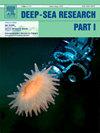Attribution of upper gyre's variability in the western Bay of Bengal boundary through Indian Ocean climate modes
IF 2.3
3区 地球科学
Q2 OCEANOGRAPHY
Deep-Sea Research Part I-Oceanographic Research Papers
Pub Date : 2025-05-15
DOI:10.1016/j.dsr.2025.104519
引用次数: 0
Abstract
The Bay of Bengal (BOB), a marginal sea of the northern Indian Ocean, experiences significant monsoon influences. Satellite observations show considerable inter-annual variability in the seasonal oceanic gyre and the summertime offshore jet extending from the Western Boundary Currents (WBC). While the Indian Ocean Dipole (IOD) mode is well-known, the recently identified Indian Ocean Tripole (IOT) mode has also attracted attention. However, the impact of the IOT mode on BOB circulation remains underexplored. This study examines the effects of the boreal autumn-matured IOD and the summer-matured IOT on BOB circulation using analyses of merged satellite data and outputs from a 1.5-layer reduced-gravity numerical model. Results indicate that both the IOD and IOT modes can influence BOB ocean circulation by generating local wind anomalies over the BOB. Unlike the IOD mode, the IOT mode induce less equatorial wind anomalies that can remotely affect the northern BOB circulation. Further analyses indicate that upper seawater warming during boreal spring leads to land-sea breezes over the western BOB, driving the western boundary offshore jet to higher latitudes. Unexpectedly, under scenario of northward offshore jet shift, the gyre response in the northern BOB and near the western boundary is more strongly attributed to wind anomalies associated with the IOT mode than the IOD mode. This study enhances our understanding of land-sea-atmosphere interactions in the marginal sea of monsoon region.
印度洋气候模态对孟加拉湾西部边界上环流变率的归因
孟加拉湾(BOB)是北印度洋的边缘海,受到季风的显著影响。卫星观测显示季节性海洋环流和夏季从西边界流延伸而来的近海急流具有相当大的年际变化。虽然印度洋偶极子(IOD)模式是众所周知的,但最近发现的印度洋三极子(IOT)模式也引起了人们的关注。然而,物联网模式对BOB流通的影响仍未得到充分探讨。本研究利用合并的卫星数据和1.5层减重数值模型的输出分析,研究了北方秋季成熟的IOD和夏季成熟的IOT对BOB环流的影响。结果表明,IOD和IOT模式都可以通过在BOB上产生局地风异常来影响BOB海洋环流。与IOD模式不同,IOT模式引起的赤道风异常较少,而赤道风异常可以远程影响北半球环流。进一步分析表明,寒带春季上层海水变暖导致北半球西部的陆海风,将西部边界近海急流推向高纬度地区。出乎意料的是,在海上急流向北移动的情景下,BOB北部和西边界附近的环流响应更强烈地归因于与IOT模态相关的风异常,而不是IOD模态。本研究提高了我们对季风区边缘海陆-海-气相互作用的认识。
本文章由计算机程序翻译,如有差异,请以英文原文为准。
求助全文
约1分钟内获得全文
求助全文
来源期刊
CiteScore
4.60
自引率
4.20%
发文量
144
审稿时长
18.3 weeks
期刊介绍:
Deep-Sea Research Part I: Oceanographic Research Papers is devoted to the publication of the results of original scientific research, including theoretical work of evident oceanographic applicability; and the solution of instrumental or methodological problems with evidence of successful use. The journal is distinguished by its interdisciplinary nature and its breadth, covering the geological, physical, chemical and biological aspects of the ocean and its boundaries with the sea floor and the atmosphere. In addition to regular "Research Papers" and "Instruments and Methods" papers, briefer communications may be published as "Notes". Supplemental matter, such as extensive data tables or graphs and multimedia content, may be published as electronic appendices.

 求助内容:
求助内容: 应助结果提醒方式:
应助结果提醒方式:


